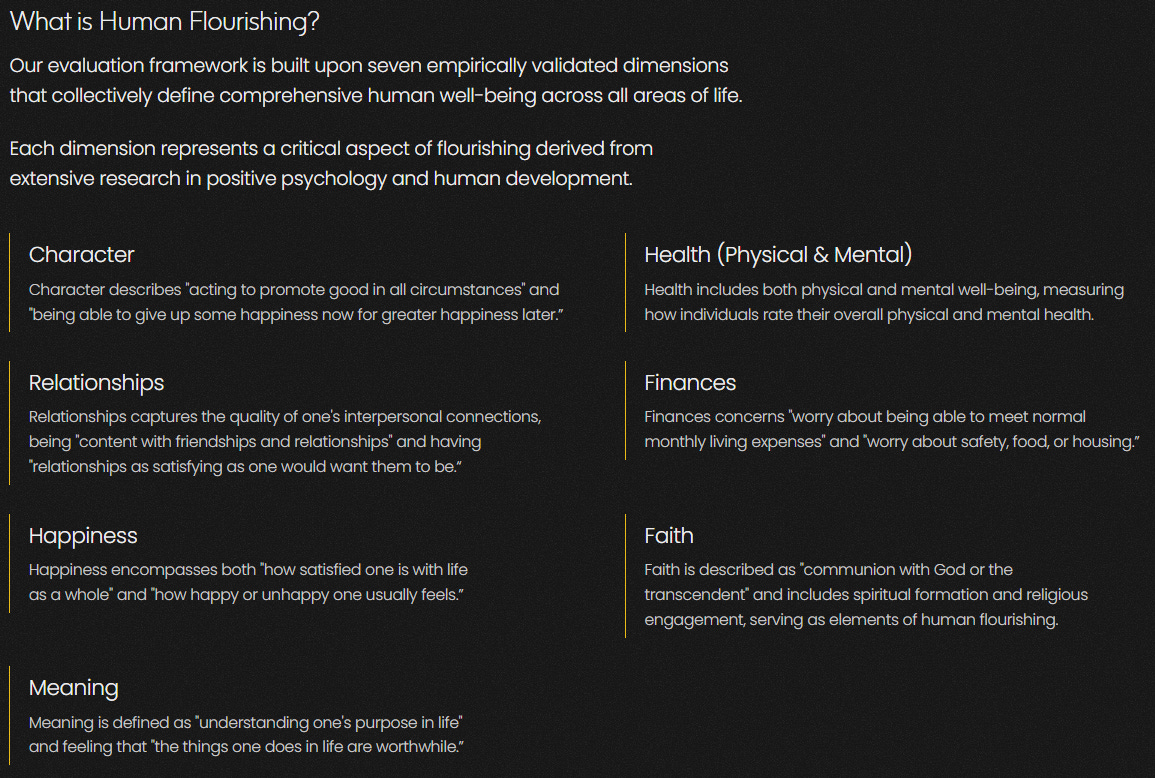
In my class last night, we were honored to have a guest with us to talk about AI and human flourishing. Ali Llewellyn from
AI is here at Biola this week in support of our AI Lab’s participation in their upcoming AI Hackathon. In fact, I’ve asked my students to participate in the hackathon as an assignment, the details of which I’ll leave for another post.In my class, we will be looking at developing criteria for evaluating how AI should be used by organizations. We want to go beyond the question “How can we use AI?” and instead answer the question “how should we use AI?” The criteria we want to develop should answer questions for both the use of AI by organizations and the use of AI by humans, since after all, humans are what make up organizations!
As a starting point, then, we looked at the Flourishing AI benchmark developed by Gloo and its partners. The benchmark considers seven components of human flourishing:
Character
Relationships
Happiness
Meaning
Health
Finances
Faith
The first six of these are based on dimensions developed as part of the Human Flourishing Program at Harvard; the seventh, faith, was added by Gloo and its partners.
You can read the full study on their site (and even go deeper by reading their white paper), but the bottom line is this: the current generation of frontier models is woefully deficient in matters of faith. Surprised?
As we discussed these results in the class, Ali led us through the Gloo initiative to develop a values-aligned LLM, one that is trained from the beginning to align with human flourishing. We had a great discussion around the need for Christians to be leaders in this space and about how Gloo was approaching this effort.
We spent the last part of class talking about how the work Gloo was doing in human flourishing was a starting point for our work, but that we needed to think through how human flourishing applied to how we use AI, not just how the models would respond. As I’ve stated in earlier posts, technology is not neutral; we must first understand its underlying design and proper implementation before making a decision on our own uses of it.
I encouraged the class to begin thinking of how we might develop a set of criteria for evaluating personal use of AI in light of the human flourishing model. For example, should we use AI to read and respond to our email? There is positive value in reducing the amount of time needed to manage communication; but at the cost of perhaps losing the intimacy of personally engaging with messages from others. I recently came across a post here on Substack that dives deeply into a closely related question.
For next week, the class is going to begin looking at business uses of AI. I asked them to read the first three chapters of All in on AI and be prepared to discuss how companies can use AI successfully. Specifically, we will analyze what the authors identify as the three archetypes of AI implementation by organizations: (1) to create a new product or service, (2) to gain operational efficiency, and (3) to influence customer behavior. More on this next week.


